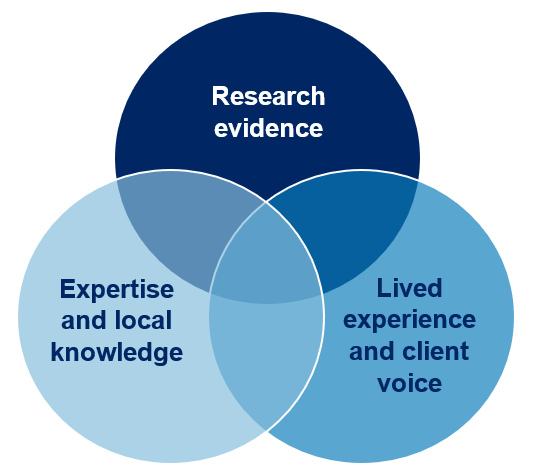What is evidence?
How we define evidence
Evidence is factual information used to support a claim or belief. It is information and research selected from the best available sources to support a decision. Evidence is used to inform decision making to achieve the most effective outcomes.
Evidence-informed decision making gives managers, leaders and practitioners confidence that their decisions are supported with the best evidence of what works, what works well, what doesn’t work and what needs to be changed.
Types of evidence
There are three different types of evidence we can use to inform decision making:

Research evidence
- information that is systematically collected through established research methods
- it comes from a range of sources, e.g. academic journal articles and published literature, analysis of statistics and data, and reports from government and non-government organisations
- it can be qualitative or quantitative information and data
Lived experience and client voice
- the views of children, young people, families and communities
- day-to-day feedback from people using your service
- this can be information collected through surveys, interviews and focus groups with clients.
Expertise and local knowledge
- professional expertise, insight and skills developed over many years
- information known about a target group or community that might influence service design and delivery (e.g. knowledge of culture and values).
Evidence can vary in strength, quality and appropriateness for your purpose. While research is only one type of evidence, it has the advantage of greater rigour and independence when compared to other types of evidence.
Types of research evidence
There are many different types of research evidence you can use in your work. Research can be quantitative, qualitative or mixed-method.
- Quantitative Research
- Quantitative research collects and analyses numerical data.
- It is used to collect often objective information (e.g. demographics), test causal relationships, make predictions and generalise results to wider populations.
- Qualitative research
- Qualitative research collects and analyses non-numerical data (e.g. text, audio).
- It provides valuable in-depth information about people’s opinions and experiences. However, it may not represent the entire target group and it can’t measure effect.
- Mixed-method research
- Encompasses both qualitative and quantitative data collection and analysis.
There are many different study designs that can used to conduct quantitative and qualitative research:
Meta-analyses: combine the results of many studies of the same program or service into a single evaluation. It is the statistical analysis of a large collection of data and results from individual studies to integrate the findings.
Systematic reviews: use an explicit and reproduceable method to systematically search, critically appraise and synthesise the findings of multiple studies on a specific topic. They are designed to provide a complete, exhaustive summary of current evidence relevant to a research question.
Randomised-controlled trials (RCTs): compare people receiving a service (treatment group) to people who do not receive a service (control group) to see if there is a significant difference in their outcomes. RCTs randomly assign participants to a treatment group or control group. This means they have greater control over factors that might influence a person’s outcomes.
Quasi-experimental studies: are similar to RCTs. They compare the outcomes of people who have received a service and people who haven’t. However, they don’t randomly allocate people to a treatment or control group.
Pre- and post-test studies: collect data from participants before and after a service to monitor changes. These studies can help us to begin to understand the impacts of our services when there are no RCTs. As they do not have a control group though, they are not as reliable as an RCT. We cannot be sure changes are a direct result of services. Changes may be due to other changes in the client’s life, natural changes in learning or development, or changes in the larger service system.
Case studies: are used to explain, describe or explore events or issues in the everyday contexts in which they occur. In contrast to experimental designs (e.g. RCTs), which seek to test a specific hypothesis through deliberately manipulating the environment, case studies can be used to capture information on more explanatory 'how', 'what' and 'why' questions. For example, 'how is the intervention being implemented and received on the ground?' (Crowe et al. 2011).
Qualitative studies: provide valuable, in-depth information about people’s experiences, behaviours, beliefs or attitudes. Non-numerical data is typically collected via interviews, focus groups, or open-ended survey questions. Qualitative study designs are beneficial for certain types of research questions, such as those looking to provide unique insights into specific contexts or social situations. However, they are not as strong when wanting to find direct cause and effect links or where a statistically significant result is required.
Last updated:
We acknowledge Aboriginal people as the First Nations Peoples of NSW and pay our respects to Elders past, present, and future.
Informed by lessons of the past, Department of Communities and Justice is improving how we work with Aboriginal people and communities. We listen and learn from the knowledge, strength and resilience of Stolen Generations Survivors, Aboriginal Elders and Aboriginal communities.
You can access our apology to the Stolen Generations.